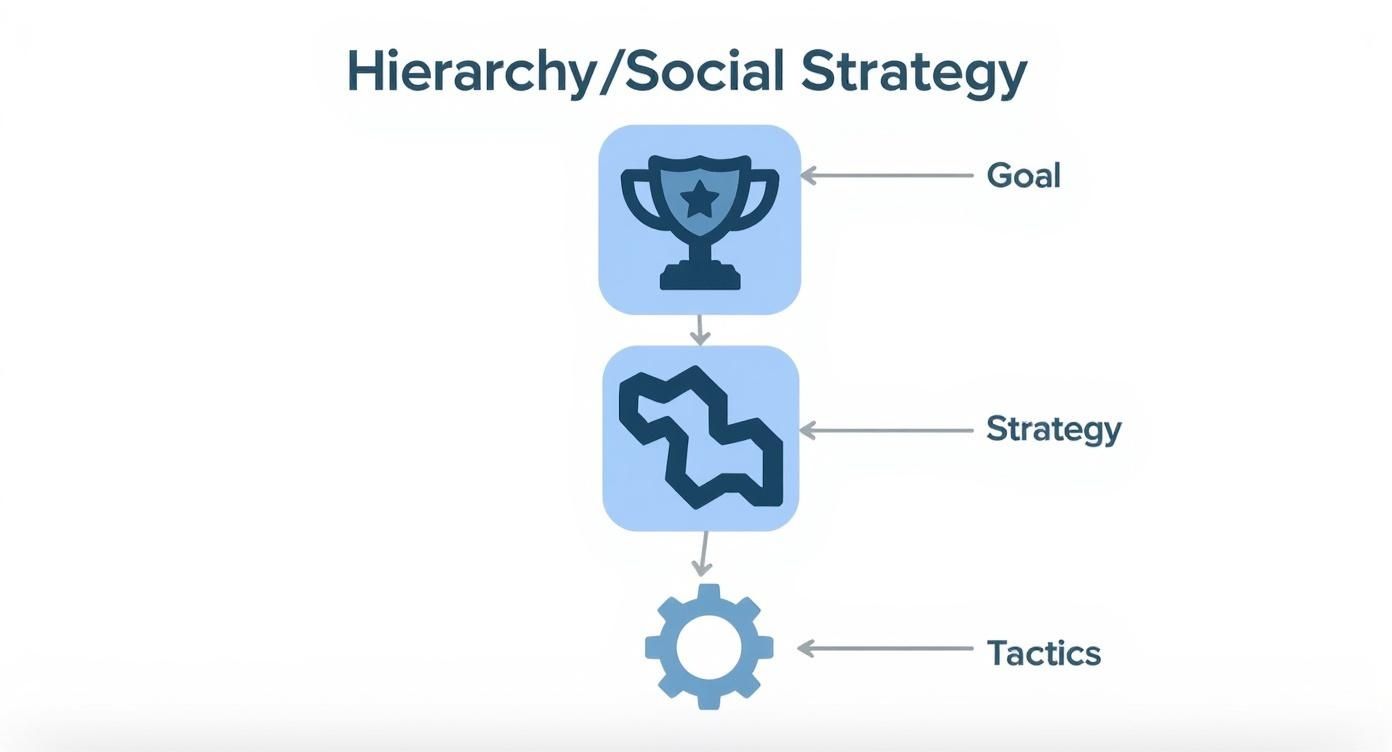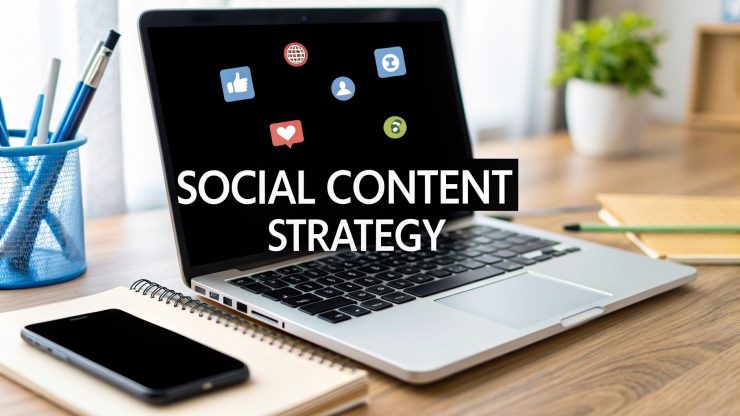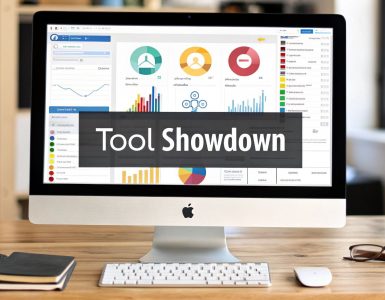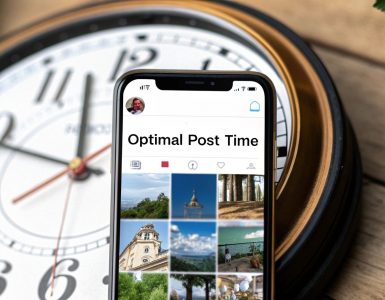So, what exactly is a social content strategy? Think of it as your master plan for everything you post on social media. It outlines what you’ll share, where you’ll share it, and when.
This strategy is the "why" behind every post, making sure your social media efforts are actually tied to real business goals, not just random updates.
Why You Need a Documented Social Content Strategy
Posting on social media without a plan is like trying to build a house without a blueprint. You might be busy nailing boards together, but you'll probably end up with a mess instead of a home. A documented social content strategy is what turns social media from a daily chore into a powerful machine that gets you results.
It’s the critical difference between just having a social media presence and using it to actively grow your business.
Moving from Random Acts to Purposeful Action
Too many businesses fall into the "random acts of content" trap. You know the one—a product photo on Monday, a team lunch pic on Wednesday, and a trending meme on Friday. While you're technically posting, this scattered approach rarely leads to meaningful results. It's just noise.
A real strategy gives you a framework to work from. It forces you to get serious and answer the big questions before you even think about posting:
- Who are we talking to? If you don't know your audience, your content will never connect.
- What are we trying to achieve? Clear goals are what make social media a tool for growth, not just a time-sink.
- How will we know if it's working? Picking the right metrics is the only way to prove your efforts are paying off.
- What do we sound like? A consistent voice and personality are what build brand recognition and trust over time.
A social media strategy maps out your goals, the tactics you'll use to get there, and how you'll measure success. Without one, you’re just posting into the void. With one, you’re making every single post, comment, and campaign count.
The Tangible Benefits of a Clear Plan
Creating a strategy isn't just about making a pretty document to file away; it delivers real-world benefits that you can see in your bottom line. To get a better sense of how this piece fits into the larger marketing puzzle, it’s worth exploring different effective social media marketing strategies to see the whole picture.
When you have a documented plan, you bring clarity and efficiency to your entire team. Everyone is aligned on the same goals, which means you stop wasting time and money on content that goes nowhere.
This focused approach ensures every post, story, or video is a deliberate move designed to hit a specific target—whether that's building brand awareness, generating new leads, or driving sales. A good strategy transforms your social media accounts from unpredictable channels into reliable assets that consistently fuel your growth.
The 6 Pillars of Your Social Content Strategy
A great social content strategy isn't built on guesswork or random acts of posting. It’s a carefully constructed machine, and these six pillars are the essential parts that make it run. Think of them as the support beams holding up your entire social media presence. Without them, your efforts will feel disconnected and, frankly, are likely to fall flat.
These pillars are what turn a vague idea—"we should post more"—into a concrete, actionable plan. They give you the clarity to move from just posting content to communicating with real purpose and getting actual results.
This infographic breaks down how your big-picture goals shape your strategy, which in turn dictates the tactical, day-to-day things you do.

As you can see, the daily posts are the very last step. They only work when they’re guided by a solid strategy that’s tied directly to your business objectives.
To help you get started, here's a quick look at the six essential components you'll need to define.
The Six Pillars of a Social Content Strategy
| Pillar | Description | Key Question to Answer |
|---|---|---|
| Audience Personas | Detailed profiles of your ideal customers. | Who, exactly, are we talking to? |
| Business Goals & KPIs | The specific outcomes you want and how you'll measure them. | What are we trying to achieve? |
| Content Themes | The core topics you'll consistently post about. | What do we talk about? |
| Platform Selection | The social channels you'll focus on. | Where will we show up? |
| Posting Cadence | Your schedule for publishing content consistently. | How often will we post? |
| Brand Voice | The unique personality and tone of your communications. | How do we want to sound? |
Getting these six elements right is the difference between shouting into the void and building a thriving community. Let's dig into what each one really means.
1. Audience Personas: Who You Are Talking To
Before you even think about writing a caption, you have to know who you’re talking to. This is where audience personas come in, and they are absolutely the most critical pillar. These aren't just broad categories like "moms" or "small business owners." They are detailed, semi-fictional profiles of your ideal customer, pieced together from real data and market research.
Give them a name, a job title, goals, and frustrations. What keeps them up at night? What apps do they scroll through on their coffee break? When you understand their world on that level, you can create content that truly connects and makes them feel like you get them.
2. Business Goals and KPIs: How You Measure Success
Your social media activity needs to have a point. It has to serve a bigger business purpose. This pillar is all about connecting your content directly to what your company actually wants to accomplish. Are you trying to get your name out there (brand awareness), find new customers (lead generation), or simply sell more stuff (drive sales)?
Once you have your goals, you need Key Performance Indicators (KPIs) to know if you're actually making progress.
- For Brand Awareness: Keep an eye on reach, impressions, and follower growth.
- For Lead Generation: Track link clicks, form sign-ups, and conversion rates.
- For Engagement: Look at the likes, comments, shares, and saves to see what content is truly hitting home.
These numbers are your proof. They transform social media from a fun-but-fuzzy expense into a measurable asset that contributes to the bottom line.
3. Content Themes: What You Talk About
Your content themes (you'll also hear them called content pillars or buckets) are the handful of core topics you’ll talk about over and over again. These themes should live right at the intersection of what your audience is genuinely interested in and what your brand is an expert on. They're what keep your feed interesting and varied, yet always focused and on-brand.
For instance, a company selling high-end kitchen gear might build their content around these themes:
- Pro-Chef Cooking Techniques
- Ingredient Deep Dives
- Kitchen Organization Hacks
- Behind-the-Scenes Product Design
Nailing these down eliminates that daily "what on earth do I post today?" panic and helps you build a reputation as the go-to source in your niche.
4. Platform Selection: Where You Show Up
You do not need to be everywhere. In fact, trying to be on every platform is a classic rookie mistake that just spreads you too thin and guarantees mediocre results across the board. The real secret is to be where your audience is already hanging out.
This is where all that work you did on your audience personas really pays off. If your ideal customer is a B2B professional making big purchasing decisions, you absolutely have to be on LinkedIn. If you’re selling a visually stunning product to Gen Z, then TikTok and Instagram are your battlegrounds. With 65.7% of the global population using social media as of 2025 and the average person juggling 6.84 different platforms a month, you have to choose wisely. You can see more stats about modern social media use on Sprinklr.com to understand just how fragmented attention has become.
Choose your channels with intention. It is a thousand times better to dominate on two perfect platforms than to be a ghost on six irrelevant ones. Go where you'll make the biggest splash.
5. Posting Cadence: How Often You Post
On social media, consistency is king. Your posting cadence is simply your rhythm—the schedule you stick to for publishing content on each platform. An all-over-the-place schedule sends a bad signal to both the algorithm and your audience, making your brand seem unreliable.
A sustainable rhythm is far more powerful than a frantic, short-lived one. It's much better to post three amazing, high-value posts every single week than it is to post twice a day for a week and then vanish for a month. Your content calendar is the tool that makes this level of consistency possible.
6. Brand Voice: How You Sound
Last but not least, your brand voice is the distinct personality your brand shows the world. Are you witty and a little sarcastic? Or are you more authoritative and serious? Maybe you're warm and inspirational, or perhaps you're direct and no-nonsense. Whatever it is, that voice has to be consistent in every post, every reply, and every single comment.
A strong voice is what makes your business feel human and relatable. It’s what helps people recognize your content instantly in a noisy feed and build a real connection with you. It’s the final pillar that ties everything together, making sure your message isn’t just seen, but actually felt.
Frameworks for Organizing Your Social Content

Okay, you’ve got your big-picture strategy mapped out. Now comes the real challenge: translating that strategy into a daily, manageable workflow. Without a solid system, even the best plans can quickly devolve into chaos, leaving you scrambling to figure out what to post each morning.
This is where content frameworks save the day. Think of them as the shelving and labeling system for your content library. They bring order to the madness and ensure you always have the right type of post ready to go. Let's dig into two of the most effective frameworks out there: content buckets and content repurposing.
Using Content Buckets to Create Balance
The content bucket framework (sometimes called content pillars) is a brilliantly simple way to categorize your posts based on the core themes you identified earlier. By assigning every single post to a specific bucket, you guarantee a healthy, balanced mix of content that keeps your audience hooked while still serving your business goals.
It’s the perfect antidote to common social media ruts, like talking too much about your product or getting stuck on the same topic for weeks. A feed with variety just feels better, and it helps you build a much more authentic connection with your followers.
A great rule of thumb to start with is the 80/20 rule. Aim for 80% of your content to be genuinely helpful, entertaining, or insightful for your audience. The remaining 20% can be reserved for direct promotion.
So, what does this look like in the real world? Imagine a software company mapping out its buckets:
- Educational Tips (40%): Sharing actionable advice and how-to guides related to their software.
- Industry Insights (20%): Posting about relevant news and trends to position themselves as experts.
- Behind-the-Scenes (20%): Humanizing the brand with team spotlights and glimpses into company culture.
- Promotional Posts (20%): Announcing new features, sharing customer success stories, and running special offers.
Sticking to predetermined categories like this completely eliminates the daily "what should I post?" panic. Your content creation becomes more predictable for you, yet remains varied and interesting for your audience.
The Art of Content Repurposing
Let’s be honest: creating high-quality content takes a ton of work. The good news? You don't have to reinvent the wheel every single day. Content repurposing is the strategic art of taking one big piece of content and slicing and dicing it into multiple smaller assets for different social platforms.
This isn't just about copy-pasting the same link everywhere. It’s about skillfully extracting the core value from a "hero" asset—like a blog post, webinar, or case study—and re-packaging it for different formats and audiences.
This approach squeezes every last drop of value out of your best work, extends the lifespan of your ideas, and frankly, saves an enormous amount of time.
How to Repurpose a Single Blog Post
Let's say you just published an amazing, 2,000-word blog post. Instead of just tweeting the link once and calling it a day, you can turn that single asset into weeks' worth of social media content.
- Create an Instagram Carousel: Pull out 5-7 key stats or takeaways and design them into a slick, swipeable carousel.
- Develop a LinkedIn Poll: Grab a thought-provoking question from the article and use it to start a conversation in a LinkedIn poll.
- Produce a Short-Form Video: Film a quick 30-second video for TikTok or Reels summarizing the three most important points from the post.
- Design a Pinterest Infographic: Condense the main data points into a tall, shareable infographic that drives traffic back to the full article.
- Write Multiple Posts for X (Twitter): Break down individual tips, quotes, and stats into a series of bite-sized posts to share over several days.
- Craft an Email Newsletter: Send a summary of the blog post to your subscribers with a clear call-to-action to read the full piece on your site.
By embracing these frameworks, you build an efficient and sustainable content machine. You ensure your social feeds are consistently valuable and aligned with your social content strategy, all while lifting the immense pressure of constant, from-scratch creation.
How to Put Your Evergreen Content on Autopilot
Imagine your social media channels humming along, consistently sharing valuable posts, even while you’re deep in a product launch or taking a much-needed vacation. This isn't a pipe dream; it's what happens when you automate your evergreen content. By building a smart system for your timeless posts, you create a reliable baseline for your entire social strategy.
This isn't about creating robotic, soulless feeds. It’s a strategic move to let technology handle the foundational, repetitive posts. That way, you can pour your creative energy into what really matters: timely campaigns, jumping on trends, and having genuine conversations with your community. It’s all about working smarter, not just harder.
First, Build Your Evergreen Content Library
Before you can automate anything, you need a solid library of your best timeless content. This is the stuff that stays relevant and useful for weeks, months, or even years. Think of it as a vault filled with proven assets, ready to be deployed at a moment's notice.
The key is to organize this library into thematic categories, or what we call "buckets." These should align directly with your content pillars. This simple structure is what keeps your automated feed balanced, varied, and interesting for your followers.
A few bucket ideas to get you started:
- Bucket 1: Quick Tips & How-Tos: Actionable advice and industry best practices your audience can use right away.
- Bucket 2: Blog Post Nuggets: Pull out the best quotes, key takeaways, and compelling stats from your top-performing articles.
- Bucket 3: Customer Wins & Testimonials: Real stories and powerful quotes that build trust and social proof.
- Bucket 4: Core Concepts Explained: Simple breakdowns of foundational ideas or problems your business solves.
Organizing your content this way is crucial. It stops your feed from becoming a broken record and guarantees you’re always providing a healthy mix of valuable posts.
The Magic of Buckets and Scheduling Tools
Once you've sorted your content into buckets, a specialized tool like EvergreenFeed can put it all to work for you. This is where the real automation happens. Instead of manually scheduling hundreds of individual posts, you just create a simple, recurring schedule for each bucket.
For instance, you could tell the system to:
- Post one Quick Tip every Monday and Wednesday morning.
- Share a Blog Post Nugget every Tuesday and Friday afternoon.
- Publish a Customer Win every Thursday.
Here’s a peek at how you can set up these content buckets right inside the EvergreenFeed dashboard to get your automated schedule running.
The tool then automatically grabs a post from the right bucket at the scheduled time. It’s a true "set it and forget it" system for your most durable content, ensuring your feed stays active with proven winners.
Automation transforms your evergreen content from a static archive into a dynamic, ongoing conversation. It guarantees you’re consistently delivering value, which is the cornerstone of building an engaged community and a strong brand presence.
Freeing Up Your Time for High-Impact Work
Let's be real—the demands on social media managers are huge. Some research suggests brands need to pump out between 48 and 72 social media posts per week just to stay visible. Automating your evergreen content is a practical way to deal with that overwhelming volume. You can find more on this in Hootsuite's comprehensive social media research.
When you let automation handle the steady drumbeat of foundational posts, you get precious hours back. This is time you can reinvest into the activities that require a human touch—the stuff that truly moves the needle. You’ll have more bandwidth for crafting timely content, engaging in real-time conversations, and digging into performance data. If you want to learn more, check out our guide on how to automate your social media posting effectively.
And it doesn't have to stop with social media. Exploring broader marketing automation strategies can unlock efficiencies across all your digital efforts, freeing you to focus on the strategic work that drives real growth.
Building Your Social Media Content Calendar
If your social content strategy is the blueprint, then your content calendar is the daily construction schedule. It’s the practical, on-the-ground tool that turns your big ideas into an actual, actionable plan. This is where your strategy gets real, transforming concepts into posts that go live right on schedule.
A great calendar is so much more than a simple list of dates. Think of it as your team's command center for mapping out campaigns, keeping your brand voice consistent across all platforms, and seeing what’s actually working. It gets rid of that daily "what should I post?" panic and brings a real sense of order and purpose to your workflow.

What Makes a Calendar Actually Work?
For your calendar to be truly effective, it needs to capture a few key details for every single post. You can definitely get by with a simple spreadsheet, but dedicated tools often make this a whole lot easier. Whatever you choose, make sure it can track the non-negotiables.
A truly functional calendar should always include:
- Platform: Which social network is this post for? (e.g., Instagram, LinkedIn, TikTok)
- Date and Time: The exact moment the post is scheduled to go live.
- Copy: The final, approved text for the caption or post.
- Visuals: A direct link or thumbnail of the image, video, or graphic.
- Links: Any URLs and tracking parameters (like UTM codes) that need to be included.
- Status: A way to track where things are in the process (e.g., Draft, In Review, Approved, Published).
By keeping all of these details in one place, your calendar becomes the single source of truth for your whole team. It prevents miscommunications and ensures every post perfectly aligns with your strategy. If you want a head start, our in-depth guide offers a fantastic walkthrough for building your first social media content calendar.
Choosing the Right Tool for the Job
The tool you pick can be anything from a free, DIY solution to a more advanced, feature-packed platform. There’s no single "best" option—it all comes down to your team's size, budget, and how complex your workflow is.
- Spreadsheets (Google Sheets, Excel): Super customizable and totally free. They're a solid starting point for small teams or solo marketers but can get messy and hard to manage as you start posting more.
- Project Management Tools (Trello, Asana): These offer much better collaboration features. Using cards and boards to visually track a post's status gives you more structure than a basic spreadsheet.
- Dedicated Social Media Platforms (Buffer, Hootsuite): These are all-in-one solutions that combine calendaring with scheduling, publishing, and analytics. It’s the most seamless approach, but it comes with a subscription cost.
The best calendar is one your team will actually use consistently. Start simple, figure out what's causing you headaches, and then upgrade to a more powerful tool when you truly need it.
Ultimately, your calendar is the engine that drives your social content strategy forward. A well-kept calendar ensures you're not just randomly posting content, but methodically executing a plan. This organized approach is more critical than ever, especially as social media advertising continues to boom. Global ad spend shot past $276 billion in 2025 and is projected to hit an incredible $406 billion by 2029, which just goes to show how central these platforms have become. Discover more insights about social media spending on inbeat.agency. A solid calendar helps you make every penny of that investment count.
Measuring and Optimizing Your Strategy
Your social content strategy isn't a "set it and forget it" document. Think of it more like a living, breathing plan that needs to adapt based on what's actually happening in the real world. This is where measurement and optimization come in, turning your hard work from a guessing game into a reliable growth engine.
Without tracking performance, you’re basically flying blind. You could be making incredible content, but you'll have no idea what’s truly connecting with your audience or why. Looking at the data consistently is how you learn to double down on what works and stop wasting time on what doesn't.
Identifying Your Key Performance Indicators
First things first, you need to focus on the numbers that actually mean something to your business. It's incredibly easy to get caught up in vanity metrics like follower counts, but they rarely paint the full picture of your success. Your metrics should always tie directly back to the business goals you set at the very beginning.
This is where Key Performance Indicators (KPIs) come into play. These are the specific, measurable numbers that tell you if you're making real progress.
- Goal: Brand Awareness? Track your reach and impressions. These show you exactly how many eyeballs are landing on your content.
- Goal: Engagement? Keep a close eye on likes, comments, shares, and saves. This is your direct feedback loop for what resonates.
- Goal: Lead Generation? Your focus should be on click-through rate (CTR) and the conversion rate of people moving from social media to your website.
A KPI isn’t just a number—it’s a signpost. It tells you if you’re heading in the right direction. Choosing the right ones ensures you’re measuring actual progress, not just staying busy.
The Rhythm of Review and Refinement
Collecting data is pointless if you never do anything with it. The secret to smart optimization is setting up a regular rhythm for reviewing your performance. This doesn't need to be some monumental task. A quick weekly or monthly check-in is usually all it takes to spot important trends and uncover insights.
During these reviews, ask yourself the tough questions. Which content pillars are getting the most love? Are my videos crushing my static images? What time of day does my audience seem to be most active? Answering these questions lets you make small, informed tweaks that really add up over time.
For a much deeper look into this whole process, check out our guide on measuring social media success.
From Insights to Actionable Improvements
Once you've figured out what's working, the final step is to turn those insights into real actions. This is how you close the loop on your social content strategy, creating a cycle of continuous improvement.
For example, maybe you notice that posts featuring customer stories get double the engagement of your product-focused posts. The next step is obvious: start creating more content around customer testimonials. This constant cycle of measuring, analyzing, and adjusting is what truly separates a thriving social media presence from one that just limps along.
Frequently Asked Questions
Even the best-laid plans come with questions. As you start to roll out your social media strategy, you'll inevitably run into a few things that make you pause. That’s perfectly normal.
Here are answers to some of the most common questions we hear, designed to give you a bit more clarity and help you push through those sticking points.
How Often Should I Post on Social Media?
This is the million-dollar question, and the honest answer is: it depends. There’s no magic number that works for everyone. The right posting frequency really comes down to the platform you're on and how your specific audience behaves.
On a fast-moving platform like X (formerly Twitter), you might post several times a day to stay in the conversation. But on LinkedIn or Facebook, 3-5 really solid posts a week is often a much better approach.
The real key here is consistency over frequency. Don't burn yourself out trying to post constantly. It's far better to create a schedule you can realistically stick with, then watch your analytics to see what resonates. The goal is to stay on your audience's radar without flooding their feeds.
What’s the Difference Between a Content Strategy and a Content Calendar?
Let's use an analogy. Think of your social content strategy as the blueprint for a house. It’s the master plan that lays out why you're building it (your goals), who it's for (your audience), and the overall design (your content pillars and themes). It's the big-picture thinking.
The content calendar, then, is your construction schedule. It’s the nitty-gritty, day-to-day plan that says exactly which pieces of content—the posts, the videos, the stories—get published, on which channel, and at what time. It brings the blueprint to life.
In short: Your strategy is the "why" and "what." Your calendar is the "when" and "where." You can't have one without the other. A strategy without a calendar is just a wish, and a calendar without a strategy is just noise.
How Long Until I See Results from My Strategy?
Social media is a long game, so patience is a must. You're building relationships and earning trust with your audience, and that simply doesn't happen overnight.
You should start seeing early signs of life—like better engagement rates or a small bump in followers—within the first 1-3 months. But for the bigger business goals, like generating qualified leads or driving sales, you should give it at least 6-12 months of consistent effort. A well-executed strategy builds on itself, and the results will compound over time. Keep a close eye on your KPIs to track what's working and tweak as you go.
Ready to put your evergreen content on autopilot and reclaim hours every week? EvergreenFeed lets you create content buckets and automatically schedule your best posts, so your social feeds are always active and engaging. Ditch the manual grind and start building a consistent presence effortlessly. Start your free trial today at EvergreenFeed.




